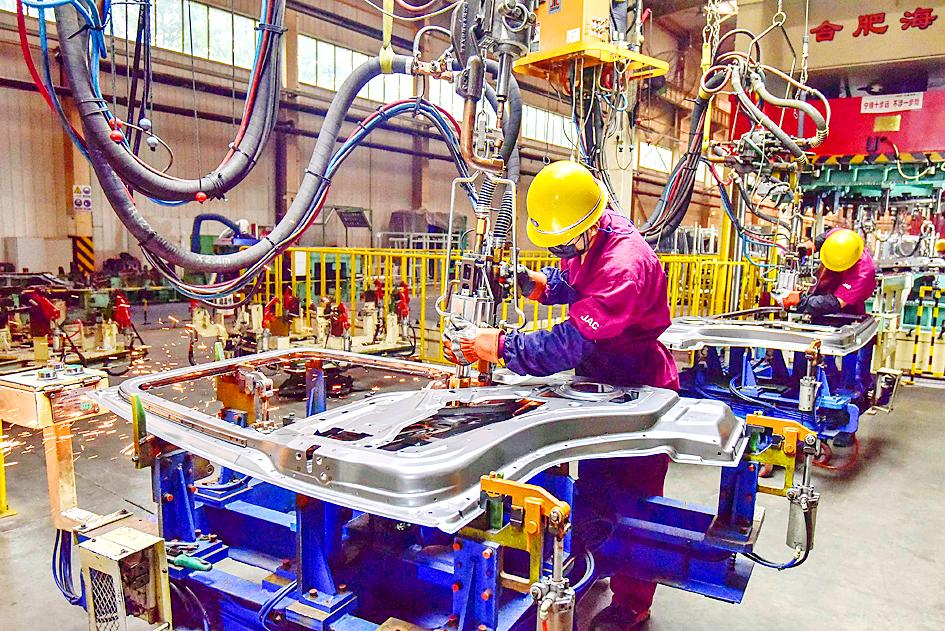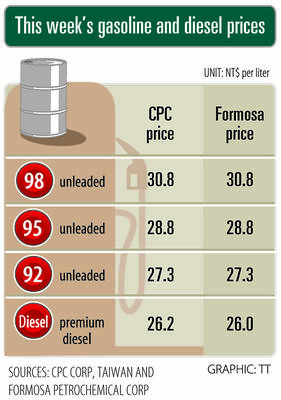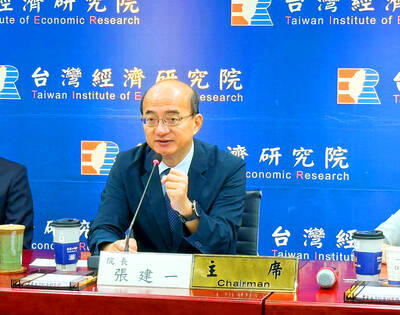Activity in China’s vast factory sector contracted last month for the first time since the COVID-19 pandemic began, the latest sign of deceleration in the world’s second-largest economy.
The drop in the official manufacturing purchasing managers’ index below 50, which signals a decline in output, shows the damage a widespread electricity crunch is having on growth.
Alongside tough measures to rein in the property market, the latest developments have led economists to pare back full-year growth predictions below 8 percent and warn that Beijing could be willing to tolerate a sharper slowdown as it tries to reform its economic model.

Photo: AFP
The problem for the economy is that manufacturing and property investment have been the main drivers of growth since the pandemic hit, while consumption growth remains relatively weak with households still cautious about travel and eating out.
Property curbs and electricity shortages, which have caused power cuts across China this week, were “a double whammy on the key drivers of growth this year,” said Bo Zhuang, China economist at Loomis Sayles Investments Asia. “A further growth slowdown is inevitable.”
Beijing is focused on preventing instability. The central bank told financial institutions that to prevent fallout from the property slowdown, which has exacerbated a debt crisis at China Evergrande Group (恆大集團), targeted financial easing aimed at the manufacturing sector might be likely.
However, economists see little prospect of relaxation on tough policy, such as curbs on housing purchases and energy use limits, until December, when Chinese President Xi Jinping (習近平) and top officials meet to set economic priorities.
“Additional policy support will need to come soon to avert a sharp deceleration in growth. The economy’s near-term outlook is highly challenging and uncertain. Headwinds include softening external demand, continued virus risks and a lack of fast, ready solutions for the energy shortages. Regulatory tightening is also a significant drag,” Bloomberg Economics said.
When the government set its growth target at “above 6 percent” in March, economists saw it as modest against their own predictions of greater than 8 percent. Many are now rethinking their views, with major banks from Goldman Sachs Group Inc to Nomura Holdings Ltd downgrading their forecasts in recent weeks to as low as 7.7 percent.
Chinese factories in 21 provinces have been hit by power cuts in the past few weeks, largely driven by a spike in coal prices that made it unprofitable for power plants to sell electricity at fixed prices. The brunt of the effect was in the official manufacturing purchasing managers’ index, which declined to 49.6 from 50.1 in August, below the 50 median estimate in a Bloomberg survey of economists.
Beijing has scrambled to solve the problem by allowing power companies to raise prices and funneling more coal to the sector. Those efforts could get production going again in many factories, but that relief might not come for weeks.
Beyond that, Beijing is signaling that it wants highly energy-intensive producers, like steel and chemical factories, to reduce output for the rest of the year, as it tries to meet environmental targets. China’s aim to reduce energy intensity, or how much power is needed to drive output, by about 3 percent this year could drag down full-year growth by 0.3 to 0.6 percentage points, said Ming Ming (明明), head of fixed income research at Citic Securities Co.
A rollback of energy intensity targets before the end of the year is unlikely, said Chen Long (陳龍), a partner at consulting firm Plenum.

SETBACK: Apple’s India iPhone push has been disrupted after Foxconn recalled hundreds of Chinese engineers, amid Beijing’s attempts to curb tech transfers Apple Inc assembly partner Hon Hai Precision Industry Co (鴻海精密), also known internationally as Foxconn Technology Group (富士康科技集團), has recalled about 300 Chinese engineers from a factory in India, the latest setback for the iPhone maker’s push to rapidly expand in the country. The extraction of Chinese workers from the factory of Yuzhan Technology (India) Private Ltd, a Hon Hai component unit, in southern Tamil Nadu state, is the second such move in a few months. The company has started flying in Taiwanese engineers to replace staff leaving, people familiar with the matter said, asking not to be named, as the

The prices of gasoline and diesel at domestic fuel stations are to rise NT$0.1 and NT$0.4 per liter this week respectively, after international crude oil prices rose last week, CPC Corp, Taiwan (台灣中油) and Formosa Petrochemical Corp (台塑石化) announced yesterday. Effective today, gasoline prices at CPC and Formosa stations are to rise to NT$27.3, NT$28.8 and NT$30.8 per liter for 92, 95 and 98-octane unleaded gasoline respectively, the companies said in separate statements. The price of premium diesel is to rise to NT$26.2 per liter at CPC stations and NT$26 at Formosa pumps, they said. The announcements came after international crude oil prices

SinoPac Financial Holdings Co (永豐金控) is weighing whether to add a life insurance business to its portfolio, but would tread cautiously after completing three acquisitions in quick succession, president Stanley Chu (朱士廷) said yesterday. “We are carefully considering whether life insurance should play a role in SinoPac’s business map,” Chu told reporters ahead of an earnings conference. “Our priority is to ensure the success of the deals we have already made, even though we are tracking some possible targets.” Local media have reported that Mercuries Life Insurance Co (三商美邦人壽), which is seeking buyers amid financial strains, has invited three financial

CAUTION: Right now, artificial intelligence runs on faith, not productivity and eventually, the risk of a bubble will emerge,’ TIER economist Gordon Sun said Taiwanese manufacturers turned more optimistic last month, ending a five-month streak of declining sentiment as concerns over US tariffs, currency volatility and China’s overcapacity began to ease, the Taiwan Institute of Economic Research (TIER) said yesterday. The manufacturing business confidence index rose 1.17 points from June to 86.8, its first rebound since February. TIER economist Gordon Sun (孫明德) attributed the uptick to fading trade uncertainties, a steadier New Taiwan dollar and reduced competitive pressure from Chinese producers. Taiwan’s semiconductor industry is unlikely to face significant damage from Washington’s ongoing probe into semiconductors, given the US’ reliance on Taiwanese chips to power artificial